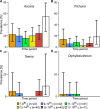Epidemiological insights from a large-scale investigation of intestinal helminths in Medieval Europe
- PMID: 32853225
- PMCID: PMC7451528
- DOI: 10.1371/journal.pntd.0008600
Epidemiological insights from a large-scale investigation of intestinal helminths in Medieval Europe
Abstract
Helminth infections are among the World Health Organization's top neglected diseases with significant impact in many Less Economically Developed Countries. Despite no longer being endemic in Europe, the widespread presence of helminth eggs in archaeological deposits indicates that helminths represented a considerable burden in past European populations. Prevalence of infection is a key epidemiological feature that would influence the elimination of endemic intestinal helminths, for example, low prevalence rates may have made it easier to eliminate these infections in Europe without the use of modern anthelminthic drugs. To determine historical prevalence rates we analysed 589 grave samples from 7 European sites dated between 680 and 1700 CE, identifying two soil transmitted nematodes (Ascaris spp. and Trichuris trichiura) at all locations, and two food derived cestodes (Diphyllobothrium latum and Taenia spp.) at 4 sites. The rates of nematode infection in the medieval populations (1.5 to 25.6% for T. trichiura; 9.3-42.9% for Ascaris spp.) were comparable to those reported within modern endemically infected populations. There was some evidence of higher levels of nematode infection in younger individuals but not at all sites. The genetic diversity of T. trichiura ITS-1 in single graves was variable but much lower than with communal medieval latrine deposits. The prevalence of food derived cestodes was much lower (1.0-9.9%) than the prevalence of nematodes. Interestingly, sites that contained Taenia spp. eggs also contained D. latum which may reflect local culinary practices. These data demonstrate the importance of helminth infections in Medieval Europe and provide a baseline for studies on the epidemiology of infection in historical and modern contexts. Since the prevalence of medieval STH infections mirror those in modern endemic countries the factors affecting STH decline in Europe may also inform modern intervention campaigns.
Conflict of interest statement
The authors have declared that no competing interests exist.
Figures







Similar articles
-
Reconstructing the history of helminth prevalence in the UK.PLoS Negl Trop Dis. 2022 Apr 21;16(4):e0010312. doi: 10.1371/journal.pntd.0010312. eCollection 2022 Apr. PLoS Negl Trop Dis. 2022. PMID: 35446843 Free PMC article.
-
Soil-transmitted helminth infections among pre-school aged children in Gamo Gofa zone, Southern Ethiopia: Prevalence, intensity and intervention status.PLoS One. 2020 Dec 15;15(12):e0243946. doi: 10.1371/journal.pone.0243946. eCollection 2020. PLoS One. 2020. PMID: 33320918 Free PMC article.
-
Market integration and soil-transmitted helminth infection among the Shuar of Amazonian Ecuador.PLoS One. 2020 Jul 31;15(7):e0236924. doi: 10.1371/journal.pone.0236924. eCollection 2020. PLoS One. 2020. PMID: 32735608 Free PMC article.
-
Important Nematodes in Children.Pediatr Clin North Am. 2022 Feb;69(1):129-139. doi: 10.1016/j.pcl.2021.08.005. Pediatr Clin North Am. 2022. PMID: 34794670 Review.
-
Current epidemiological evidence for predisposition to high or low intensity human helminth infection: a systematic review.Parasit Vectors. 2018 Jan 31;11(1):65. doi: 10.1186/s13071-018-2656-4. Parasit Vectors. 2018. PMID: 29382360 Free PMC article.
Cited by
-
Historic and Prehistoric Epidemics: An Overview of Sources Available for the Study of Ancient Pathogens.Epidemiologia (Basel). 2022 Oct 7;3(4):443-464. doi: 10.3390/epidemiologia3040034. Epidemiologia (Basel). 2022. PMID: 36547255 Free PMC article. Review.
-
Population genomics of ancient and modern Trichuris trichiura.Nat Commun. 2022 Jul 6;13(1):3888. doi: 10.1038/s41467-022-31487-x. Nat Commun. 2022. PMID: 35794092 Free PMC article.
-
Sedimentary ancient DNA as part of a multimethod paleoparasitology approach reveals temporal trends in human parasitic burden in the Roman period.PLoS Negl Trop Dis. 2025 Jun 10;19(6):e0013135. doi: 10.1371/journal.pntd.0013135. eCollection 2025 Jun. PLoS Negl Trop Dis. 2025. PMID: 40493646 Free PMC article.
-
Reconstructing the history of helminth prevalence in the UK.PLoS Negl Trop Dis. 2022 Apr 21;16(4):e0010312. doi: 10.1371/journal.pntd.0010312. eCollection 2022 Apr. PLoS Negl Trop Dis. 2022. PMID: 35446843 Free PMC article.
-
Schistosome Infection Impacts Hematopoiesis.J Immunol. 2024 Feb 15;212(4):607-616. doi: 10.4049/jimmunol.2300195. J Immunol. 2024. PMID: 38169327 Free PMC article.
References
Publication types
MeSH terms
Substances
Grants and funding
LinkOut - more resources
Full Text Sources
Miscellaneous

